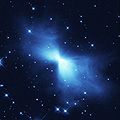Податотека:Boomerang nebula.jpg

Големина на овој преглед: 600 × 600 пиксели. Други разделности: 240 × 240 пиксели | 480 × 480 пиксели | 768 × 768 пиксели | 1.024 × 1.024 пиксели | 1.590 × 1.590 пиксели.
Изворна податотека (1.590 × 1.590 пиксели, големина: 249 КБ, MIME-тип: image/jpeg)
Историја на податотеката
Стиснете на датум/време за да ја видите податотеката како изгледала тогаш.
| Датум/време | Минијатура | Димензии | Корисник | Коментар | |
|---|---|---|---|---|---|
| тековна | 17:29, 19 мај 2007 |  | 1.590 × 1.590 (249 КБ) | Pamputt | {{Information |Description= |Source= |Date= |Author= |Permission= |other_versions= }} |
Употреба на податотеката
Податотекава се користи во следнава страница:
Глобална употреба на податотеката
Оваа податотека ја користат и следниве викија:
- Употреба на ar.wikipedia.org
- Употреба на ast.wikipedia.org
- Употреба на bn.wikipedia.org
- Употреба на ca.wikipedia.org
- Употреба на cs.wikipedia.org
- Употреба на da.wikipedia.org
- Употреба на de.wikipedia.org
- Употреба на en.wikipedia.org
- Употреба на en.wikiversity.org
- Употреба на en.wiktionary.org
- Употреба на es.wikipedia.org
- Употреба на eu.wikipedia.org
- Употреба на fa.wikipedia.org
- Употреба на fi.wikiversity.org
- Употреба на fr.wikipedia.org
- Употреба на he.wikipedia.org
- Употреба на hu.wikipedia.org
- Употреба на hy.wikipedia.org
- Употреба на id.wikipedia.org
- Употреба на it.wikipedia.org
- Употреба на it.wikibooks.org
- Употреба на ja.wikipedia.org
- Употреба на ko.wikipedia.org
- Употреба на lb.wikipedia.org
- Употреба на nl.wikipedia.org
- Употреба на nn.wikipedia.org
Погледајте ја останатата глобална употреба на податотекава.


